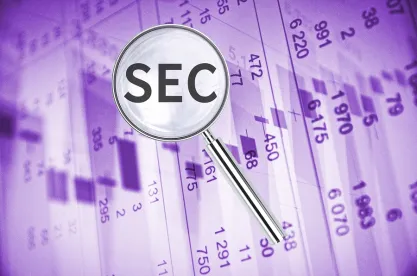On March 30, 2022, the Securities and Exchange Commission (the “SEC”) proposed a set of rules and amendments governing special purpose acquisition companies (“SPACs”) that will, if adopted, impose significant new regulatory hurdles for SPAC-related transactions, as well as expand potential bases for liability. The SEC states that the new rules are intended to increase the regulatory parity between traditional initial public offerings (“IPOs”) and SPAC IPOs and business combinations with SPACs (“de-SPACs”), as well as to provide greater transparency and protections to investors. The 372-page SEC release proposes rules that would impose new disclosure requirements for SPACs, new and revised rules surrounding de-SPACs, revised guidance aligning the use of projections in de-SPAC SEC filings and traditional IPO filings, new financial statement requirements for de-SPAC business combinations and other reverse mergers and a new safe harbor for SPACs relating to investment company status which could impose additional limits on the lifespan of a SPAC and other requirements. These proposals follow statements made by SEC Chair Gary Gensler and other SEC personnel last year which previewed future tightening of regulations for SPAC transactions and disclosures by the Commission.
While the changes would be sweeping, the proposed rules cover roughly six distinct areas:
-
Specialized SPAC disclosure requirements;
-
Aligning de-SPAC transactions with traditional IPOs;
-
Business combinations involving shell companies;
-
Increased projections disclosures;
-
Investment Company Act safe harbor for SPACs; and
-
Fairness of the de-SPAC transaction
We do not expect final rules to be adopted until the fourth quarter of this year at the earliest, due to their length, complexity and contentiousness. The proposed rules are open for public comment until the later of May 31, 2022 or the date that is 30 days after their official publication in the Federal Register. Due to the significant number of rules and amendments being proposed, and the implications of those measures, the SEC is likely to receive a substantial number of comment letters, and the final rules may be subject to legal challenges.
Specialized SPAC Disclosure Requirements
The SEC is proposing a new subpart of Regulation S-K setting forth specialized disclosure requirements for SPAC IPOs and de-SPAC transactions. The new subpart would:
-
Add SPAC-related definitions. Notably, the term “SPAC sponsor” would be defined as the entity/or person(s) primarily responsible for organizing, directing or managing the business and affairs of a SPAC. This change to add natural persons will mean that certain individuals could be subject to the enhanced disclosure requirements applicable to SPAC sponsors described below.
-
In de-SPAC transactions, mandate disclosure of additional information about the sponsor, its affiliates and any promoters of the SPAC in filings related to the SPAC and the target company, including:
-
the experience, material roles and responsibilities of these parties;
-
an organizational chart displaying the relationship between the SPAC and these parties;
-
tabular disclosure of the material terms of any lock-up agreement with these parties; and
-
the nature and amounts of all compensation that has or will be paid to these parties.
-
-
Require disclosure of actual or potential material conflicts of interest between the sponsor or its affiliates or the SPAC’s officers, directors or promoters, on the one hand, and public investors, on the other hand, as well as disclosure of the fiduciary duties each officer and director of the SPAC owes to other companies.
-
Require additional disclosure describing the potential for dilution in both registration statements filed by SPACs and for filings related to de-SPAC transactions. Among other things, this would require SPACs to describe in their registration statements material potential sources of future dilution following their IPOs.
-
Simplify cover page and prospectus summary disclosures and mandates the “plain English” disclosure of certain items for the registered offerings of SPACs and for de-SPAC transactions.
-
Require a statement from the SPAC as to whether it reasonably believes that the de-SPAC transaction and any related transactions are fair or unfair to public investors and whether it has received any independent report or opinion relating to the fairness of the de-SPAC, and other related procedural requirements for de-SPAC transactions (further discussed in the section “Fairness of the de-SPAC Transaction”).
Notably, many SPACs already disclose at least some of this information, in light of prior guidance from and commentary by the SEC. Many of the proposed rules, however, are new requirements, and others are an expansion on areas that the SEC has focused on during its comment review process.
Align De-SPAC Transactions with Traditional IPOs
Based on the SEC’s proposal and prior comments made by the Commission, the SEC is seeking to impose many of the same obligations and liabilities applicable to a traditional IPO to de-SPAC transactions. This proposed set of changes can be divided into six parts:
-
PSLRA Safe Harbor
The Private Securities Litigation Reform Act of 1995 (the “PSLRA”) provides a safe harbor for forward-looking statements accompanied by meaningful cautionary language in certain situations. The PSLRA expressly bars such safe harbor from applying to forward-looking statements made in connection with, among other things, traditional IPOs or securities offerings by blank check companies. In the current framework, in a de-SPAC transaction, SPACs are already past their IPO and are typically not considered to be blank check companies because the de-SPAC transaction intrinsically is about a merger with an operating company. Even though a de-SPAC has a risk profile that resembles that of a traditional IPO, where financial projections and forecasts would not be protected by the PSLRA, in the de-SPAC context, the SPAC is nevertheless able to take advantage of the PSLRA’s safe harbor protection in securities litigation about those projections, although many de-SPACs do not claim the safe harbor currently. This is of particular importance during the de-SPAC phase, where it is common to publish projections of the target company’s performance and include such projections in the registration statement or proxy statement relating to the de-SPAC transaction. As such projections are inherently forward-looking, they have fallen into the purview of the PSLRA’s safe harbor, potentially gaining protection that those same projections would not be entitled to in a traditional IPO.
In a statement released last April, then-Acting Director of the Division of Corporate Finance John Coates noted that in his view a de-SPAC transaction is functionally equivalent to a traditional IPO, and therefore hinted that the PSLRA’s safe harbor may not apply to forward-looking statements provided in connection with a de-SPAC transaction. The SEC’s proposed rules, if enacted, would have the same result that Coates suggested but follow a different method for achieving it, as they seek to modify the definition of “blank check company” for the purposes of the PSLRA to include SPACs, even though the de-SPAC transaction is designed to become an operating, not a blank check, company. This would prevent SPACs from utilizing the safe harbor for forward-looking statements during their de-SPAC process, raising the possibility of increased liability for financial projections and other forward-looking statements, and potentially discourage the use of forward-looking statements in the de-SPAC context. SPACs that still opt to include projections in their public statements will be subject to additional disclosure as discussed further below.
- Underwriter Status and Liability
The SEC is proposing a new rule that potentially dramatically expands the liability of investment banks and other advisors to SPACs and participants in the de-SPAC process. Proposed Rule 140a would deem any party that acted as an underwriter in a SPAC IPO and that facilitates the de-SPAC transaction or any related financing transaction, or otherwise participates (directly or indirectly) in the de-SPAC, to be engaged in the distribution of the securities of the surviving public entity in a de-SPAC. This would make any such party a statutory underwriter (that is, an underwriter by definition of law) for Securities Act liability purposes. Significantly, while not covered by proposed Rule 140a, the SEC indicates in the proposed release that other participants could potentially also be deemed to be statutory underwriters (under traditional securities doctrines, apart from the proposed rule) including in some cases financial advisers, investors in the SPAC’s PIPE transaction and other advisers. Practically, the implementation of Rule 140a may result in investment banks performing more burdensome due diligence on the target of de-SPAC transactions, and requiring an indemnity and other protections, in order to mitigate the resulting risk for the investment bank and other participants that may be at risk of liability. The extent to which, and uncertainty regarding whether, other participants in the transaction could be considered underwriters could further impact the desirability of participating or investing in these transactions.
- Aligning Non-Financial Disclosures in de-SPAC Disclosures
The SEC has also proposed rules that would require additional disclosures regarding the target company in filings related to de-SPAC transactions, including: description of the target’s business, property and legal proceedings of the target; changes in and disagreements with accountants on accounting and financial disclosures; beneficial ownership disclosures and recent sales of unregistered securities.
Although this information is already required by the Form 8-K that companies file within four business days of completing a de-SPAC, known as the “Super Form 8-K”, the proposed rules will require the same information be included in the registration statement or proxy statement or information statement filed in connection with the de-SPAC. Notably, this means that any material misstatements or omissions in the foregoing information would subject the SPAC and others to liability under the more exacting liability regime of Sections 11 and 12(a) of the Securities Act in connection with the registration statement used for the de-SPAC transaction.
- Minimum Dissemination Period
The SEC proposes that a prospectus, proxy statement or information statement filed in connection with a de-SPAC transaction be distributed to shareholders at least 20 calendar days in advance of a shareholder meeting or earliest date of an action by written consent. Currently, there is no federally-mandated minimum period of time, and it can be as short as 10 calendar days depending on the structure of the de-SPAC and the state of incorporation of the SPAC.
- Target Company Becoming Co-Registrant on S-4/F-4
The SEC has also proposed to amend Form S-4 and Form F-4 to require the target company to sign on as a co-registrant on these registration forms when filed by the SPAC pursuant to a de-SPAC transaction. Consequently, the additional signatories to the form, including the target and the target’s principal executive officer, principal financial officer, controller/principal accounting officer and board members could be liable for any material misstatements or omissions in the registration statement under Section 11 of the Securities Act, which carries strict liability for an issuer of securities, in addition to any potential liability under Sections 12(a)(2) and Rule 10b-5 that they could have under the current rules. Although some potential defendants in Section 11 claims are able to rely on a due diligence defense to escape liability, the issuer has no due diligence defense and it is not clear whether a target subject to a Section 11 claim under the proposed rule would be able to avail themselves of that defense.
- Re-Determination of Smaller Reporting Company Status
Currently, most SPACs qualify as smaller reporting companies, and the surviving entity of a de-SPAC is typically permitted to retain that status until the next annual determination date at the end of the fiscal year, even if the target company would not have qualified as a smaller reporting company prior to the de-SPAC. Practically, this results in some post-de-SPAC businesses remaining eligible to comply with certain of the less onerous, scaled disclosure requirements that they would otherwise be ineligible to rely upon.
In light of this feature of the SPAC reporting rules, the SEC’s proposal would require a re-determination of smaller reporting company status following the completion of the de-SPAC transaction. This re-determination would occur prior to the post-combination business making its first SEC filing, to be reflected in its first periodic report (Form 10-K or Form 10-Q) following the de-SPAC transaction closing.
Business Combinations Involving Shell Companies
The SEC has also proposed adopting the new Rule 145a, which would deem any business combination of a reporting shell company involving a non-shell company entity to involve a sale of securities to the reporting shell company’s shareholders under Section 2(a)(3) of the Securities Act. As a result, de-SPAC transactions and other reverse mergers involving a public shell company would be subject to the Securities Act and may require registration, even if now the transaction could be completed without registration.
The SEC has also proposed modifying the financial statement requirements in business combinations involving shell companies to more closely align the financial statement reporting requirements with those in traditional IPOs. The proposed modifications would affect, among other things, the number of years of financial statements required, audit requirements, the age of the financial statements, the inclusion of financial statements of other businesses acquired or likely to be acquired by the shell company and the use of historical financial statements of the shell company in subsequent filings. This proposed rule would ease the financial reporting burden on shell companies involved in business combinations. It would streamline the financial reporting requirements for the SPAC during a de-SPAC primarily by eliminating the need to include financial statements of the SPAC for the period prior to the de-SPAC if certain conditions are met.
Enhanced Projections Disclosure
The SEC has also proposed two new rules regarding use of projections. First, the SEC proposes an amendment to Item 10(b) of Regulation S-K that would apply to both SPAC and non-SPAC issuers. The amended rule would still require projected financial information to have a reasonable basis, but would add a requirement that any projections not based on historical financial results or operational history be clearly distinguished from those that are. It would also require that projections based on financial results and operational history be presented with equal or greater prominence compared to those not so based, and that projections including a non-GAAP financial measure should include an explanation of the measure used, a description of the corresponding GAAP measure and an explanation as to why the non-GAAP measure was used over the GAAP measure. The amended rule would also be amended to clarify that it applies to all projected financial information, including that of a target company.
The SEC also proposed a new Item 1609 of Regulation S-K that would only apply to de-SPAC transactions. The new item would require additional disclosures related to projections, including:
-
with respect to any projections disclosed by the registrant, the purpose for which the projections were prepared and the party that prepared the projections;
-
all material bases of the disclosed projections and all material assumptions underlying the projections, and any factors materially impacting such assumptions; and
-
whether the disclosed projections still reflect the views of the board or management of the SPAC or target company, as applicable, as of the date of filing; if not, then discussion of the purpose of disclosing the projections and the reasons for any continued reliance by the management or board on the projections.
Proposed Investment Company Act Safe Harbor
Proposed Rule 3a-10 would provide SPACs with a safe harbor, if certain conditions are met, from the definition of “investment company” under the Investment Company Act (the “ICA”). Under the proposed rule, in order to take advantage of the new safe harbor, a SPAC would be required to:
-
have assets consisting of only government securities, government money market funds and cash;
-
seek only a single de-SPAC transaction, after which the surviving entity will be primarily engaged in the business of the target company, which is not that of an investment company, and where the surviving entity has at least one class of securities listed on a national securities exchange;
-
announce a business combination agreement no later than 18 months after the effective date of the SPAC’s IPO registration statement, and complete the de-SPAC transaction no later than 24 months after the effective date of the SPAC IPO’s registration statement;
-
promptly liquidate should it not meet either of the 18- or 24-month deadlines; and
-
be primarily engaged in the business of seeking to complete a de-SPAC transaction, evidenced by the activities of its officers, directors and employees, its public representations of policies and its historical development.
Fairness of the de-SPAC Transaction
Proposed Item 1606 would require additional disclosure regarding potential conflicts of interest and incentives in the de-SPAC process. The proposed rule would require a statement from the SPAC itself as to whether it believes the de-SPAC and any related financing transactions (i.e., a PIPE) are fair to public investors, as well as the bases for this determination. Such a statement would be included in the de-SPAC’s Form S-4 or F-4, or Schedules 14A, 14C and TO. The proposed item would also require the SPAC to disclose whether any director voted against, or abstained from voting on, approval of the de-SPAC transaction/related financing transactions. SPACs will also be required to disclose the reasons for the dissent of any director.
Item 1606 would further require SPACs to discuss in “reasonable detail” the material factors upon which their reasonable belief of fairness is based. As part of their proposal, the SEC suggested such factors to include, non-exhaustively: the valuation of the target; the consideration of financial projections; any fairness report or opinion issued by a third party and the dilutive effects of the de-SPAC on non-redeeming shareholders. We anticipate that this rule, if adopted, would drive more SPACs to request a fairness opinion from a financial advisor.
Finally, the SEC is proposing to require disclosures on whether: the de-SPAC or any related financing transaction is structured so that the approval of a majority of unaffiliated security holders is required; a majority of directors who are not employees of the SPAC has retained an unaffiliated representative to act solely on behalf of unaffiliated security holders for purposes of negotiating the terms of the de-SPAC transaction or any related financing transaction and/or preparing a report concerning the fairness of the de-SPAC transaction or any related financing transaction and; the de-SPAC transaction or any related financing transaction was approved by a majority of the directors of the SPAC who are not employees of the SPAC.
Timeline for Comment and Adoption
We do not expect final rules to be adopted until the fourth quarter of this year at the earliest, due to their length, complexity and contentiousness. The proposed rules are open for public comment until the later of May 31, 2022 or the date that is 30 days after their official publication in the Federal Register. Due to the significant number of rules and amendments being proposed, and the implications of those measures, the SEC is likely to receive a substantial number of comment letters. The SEC will take any comments it receives into consideration when drafting the final rules, which will then be voted on by the SEC Commissioners. The final rules may also be the subject of legal challenges because of their broad effect. The proposed rules do not suggest whether the final rules will be implemented on an immediate basis or whether there will be a transition period for compliance.
Frank Zarb and Simon J. Wood contributed to this article.








 />i
/>i

